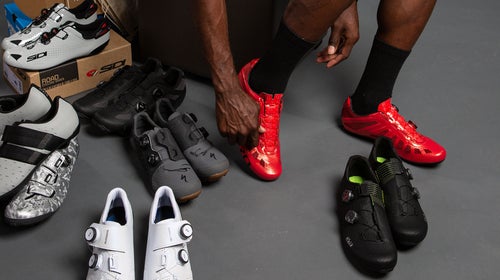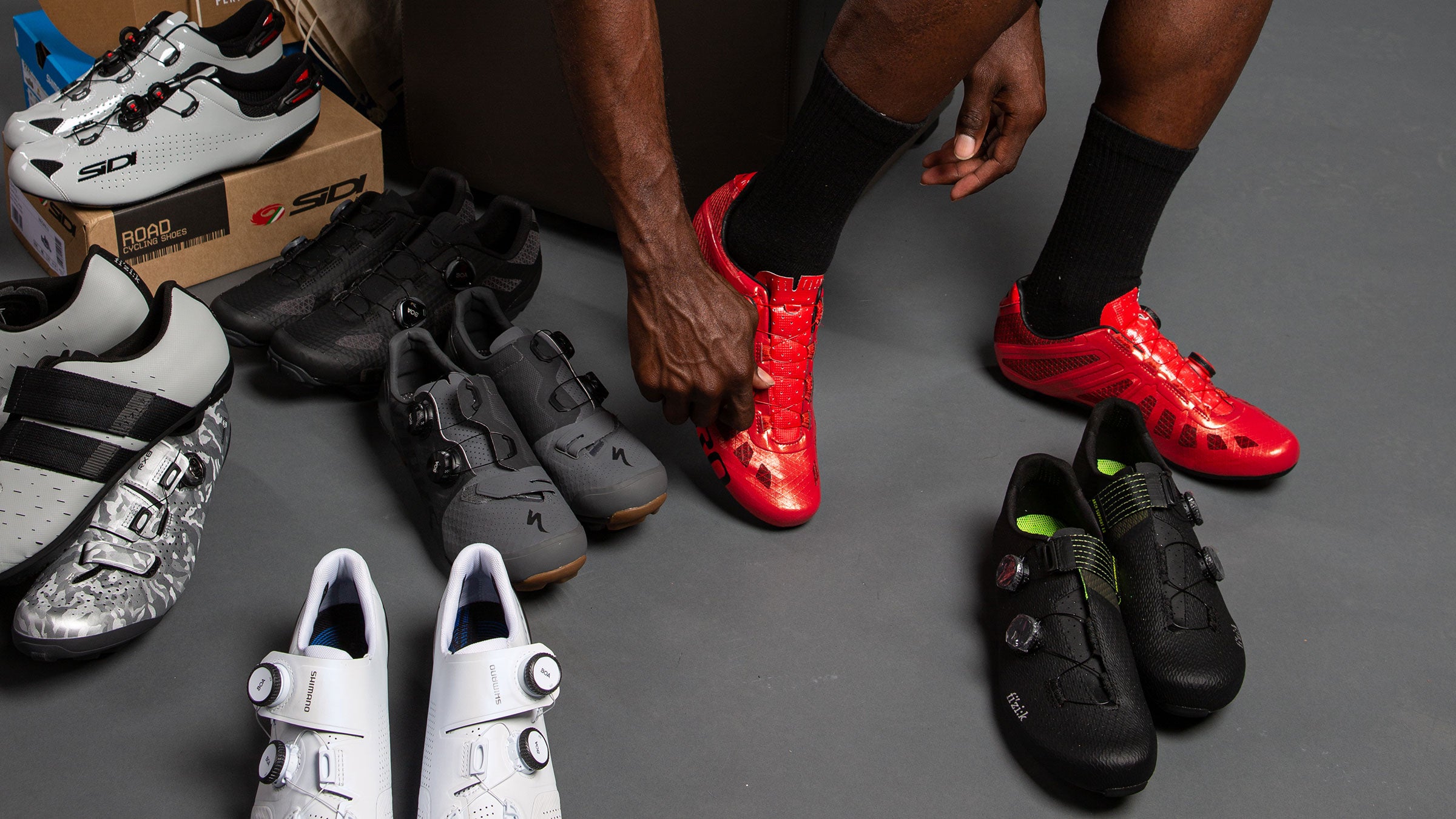Choosing the appropriate cycling footwear can be a daunting—if not bewildering—proposition, which is strange when you consider that if you’re doing bikes right, your feet will hardly even touch the ground. Of course, what shoes you wear depends on where you ride, what you ride, when you ride, and how you ride. Do you want a stiff shoe, or one with some flex? Do you want to be locked into your pedal, or free to move your foot about at will? And what do you wear when it’s cold? Between marketing jargon and the commonly-accepted cycling “wisdom,” there’s lots of conflicting information out there, so here’s my sweeping no-nonsense survey of the footwear landscape to help you decide:
Road Shoes (Clipless)
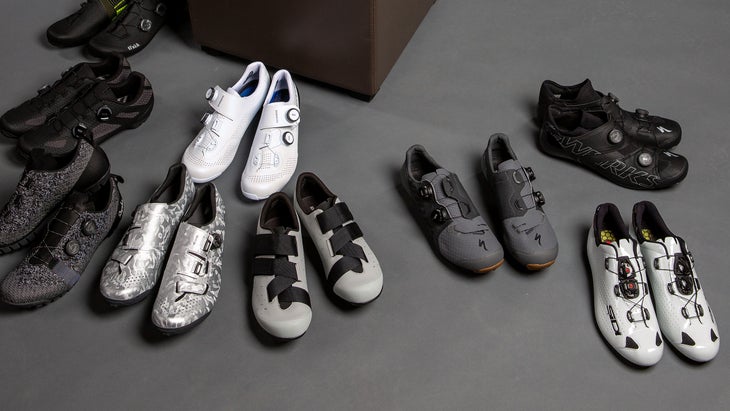
Road shoes are for riding road bikes. They’re light and stiff-soled, for use with a clipless road pedal. What makes a pedal a “road” pedal? Generally, it means they offer a relatively wide platform for support and a narrow profile for cornering clearance, all at the expense of walkability, which is fine because you only need to walk on a road ride when you’re waddling to the bathroom.
People say once you start riding “seriously” (whatever that means) that you should use clipless pedals. This is like saying once you get seriously into cinema you should only watch films in black and white. In fact, clipless is merely a matter of personal preference. If you’ve tried it and didn’t like it, then feel free to let it go. Pick a road shoe only if the idea of being clipped in appeals to you, and you ride a road bike while wearing Lycra, and you don’t get off it unless you have to. People make a big deal about using shoes with stiff soles for road riding, but it doesn’t matter, and in fact a little flex in that area is often worth it for comfort. In my opinion, the phrase “added power transmission” is mostly nonsense, and you’ll curse your super-stiff soles when you’re getting hotspots 40 miles into your ride.
Besides fit, probably the most important aspect of a road shoe is the closure system, which is also mostly a matter of preference. Some people like laces, some like Velcro, some like ratchets, and some like those newfangled Boa closure systems. To confuse you further, some manufacturers will include multiple systems on one shoe. Go with whichever one makes sense to you.
Keep in mind that when it gets cold you’ll need some kind of shoe cover. Also, keep in mind that—for most riders—the only thing that matters less than shoe stiffness is shoe weight. Choosing a road shoe for the weight is like choosing a mattress for the color. Steel-toed work boots might be a tad too weighty, but no road shoe is prohibitively heavy. If a road cycling shoe is too heavy for you then you should give up pedaling altogether and get one of those .
Mountain Shoes (Clipless)
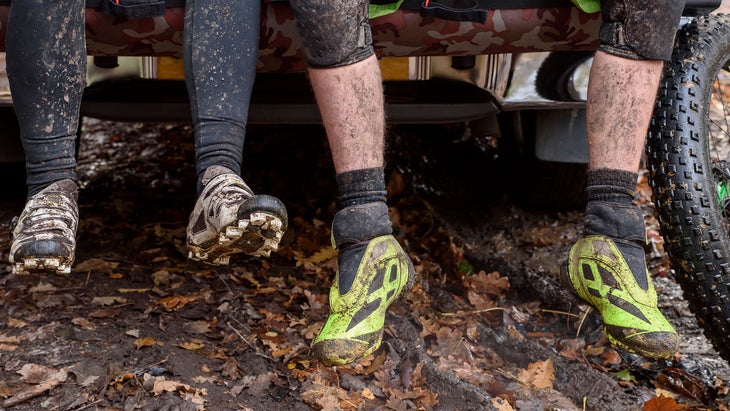
Mountain bike shoes come in all different varieties, from cross-country race shoes that aren’t much different from road shoes, to freeridey sneaker-type shoes, to trekky hiking-shoe like models. Your choice depends on how and where you ride, and whether or not you spend any time off the bike. The common denominator is that all of these shoes accept mountain bike cleats, which offer clipless connectivity while adding a degree of walkability.
Also, you can use any “mountain” shoe with your road bike if you want, but if you meet the conditions for a road shoe (i.e. you never get off your bike) you might as well stick with a road-optimized shoe and pedal system.
The main advantage of clipless pedals and shoes off-road is that they keep you connected to the pedals, which makes it much easier to pop your rear wheel up over obstacles, and if you’re racing or prioritizing speed they may be a good choice. The main disadvantage of clipless pedals and shoes off-road (besides the fact they make you lazy and you forget how to bunnyhop) is that…they keep you connected to the pedals, which is annoying if you like to change foot position, or disengage on techy sections, or like to remove your foot from the pedal whilst engaging in mid-air shenanigans, or you just don’t want to bother. As on the road, clipless is merely a matter of personal preference, not a prerequisite to “real” cycling. If you don’t need it or prefer not to deal with it, then skip all the clicky-clicky stuff and opt for…
Mountain Shoes (Flat Pedal)
While these, too, come in different styles for different types of riding, the main difference between them and your sneakers is that bike-specific shoes will generally prioritize stiffness and grip over walkability, though some models are quite walkable anyway. If you’re riding hard, landing hard, and so forth, you’ll probably want bike-specific flat pedals shoes, but if if you’re the type who’s perfectly happy to rip around in a t-shirt and cutoffs you may find you’re perfectly well-served by…
Your Sneakers
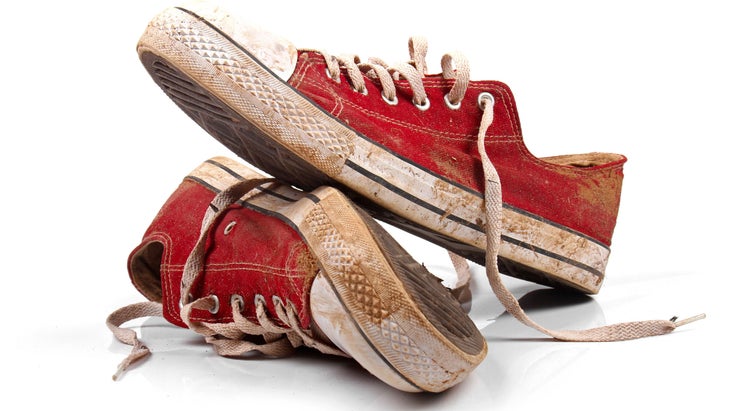
While the bike and apparel industry have decided there’s such a thing as “cycling shoes,” every shoe is potentially a cycling shoe. Of course, some sneakers are better than others, and generally you’ll want to avoid the sort of thick, shaped, soft soles you find on , or the soft sock-like uppers of high-end running shoes. Dress shoes, high heels, and the like are also generally non-starters for sport-oriented cycling, though for obviously anything goes.
As for spirited riding, skate shoes, indoor soccer shoes, or any shoe that marries a stiff, durable upper to a flat rubber sole are good candidates for cycling (so long as you tuck in your laces), will work excellently for nearly every type of riding, are as good or better than most cycling shoes in many cases, and will reduce your fuss factor to near-zero. Don’t overthink it, just use some pedals with a wide platform and good grip and let ‘er rip.
If you prefer clipless there are lots of SPD-compatible sneakers out there, but those are just a gateway drug to the freedom and joy of cycling in regular sneakers. (Unless you’re riding a fixie and rely on the foot retention to stop.)
What About Socks?
Merino.
And What About When It’s Cold?
If you want to retain the functionality of your clipless road our mountain bike shoe, and those pull-over booties aren’t cutting it, there are high-tech winter-specific versions of each that will allow you to do so…but that doesn’t mean you need to bother with them, and you may not want to spend the money on winter-specific cycling shoes (the good ones are expensive!) just to keep you tootsies warm for a couple months.
Sometimes the best solution when it’s really cold is platform pedals and a pair of insulated, lugged hiking boots. They’ll keep you warm. They’ll give you grip. They’ll keep your feet dry. You won’t get iced out of your clipless pedal, and if you need to dismount due to ice or snow you can walk easily. At most you may have to adjust saddle position slightly to account for the added sole thickness.
Sure, you may be determined to ride in Lycra all winter long…but why? Flat pedals, flat tires, hiking boots and wool will get you through the winter without having to buy a bunch of cold weather stretchy stuff of dubious utility and getting dressed up like a SCUBA diver.
You Shouldn’t Ride In Sandals, Right?
Absolutely wrong. There’s a notion floating around in the cycling world that riding in sandals is dangerous, and if you ride around with your little piggies exposed you’re liable to lose them all. Sure, your toesies could meet with an unfortunate accident, but so can the rest of you, and you’ll never hear anyone say you shouldn’t ride around with exposed fingers. There are even SPD-compatible sandals out there, but like their sneaker cousins they sort of defeat their own purpose, like wearing a necktie with no shirt.
The one situation in which sandal-cycling can be a bad idea is mountain biking on rocky terrain, where you could certainly scrape the hell out of your feet without the protection of a full shoe. Other than that, sandals will keep you cool and comfortable in the heat, and if the cycling world made any sense they’d be de rigeur rather than “alt.” Plus, you can ride in the rain as well as through puddles and stream crossings without your feet staying all waterlogged for the next several hours.
If anything, you probably shouldn’t ride in shoes during the summer, and if you don’t believe me then smell the inside of yours afterwards.
